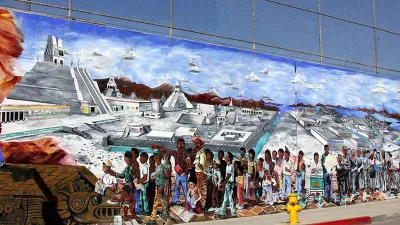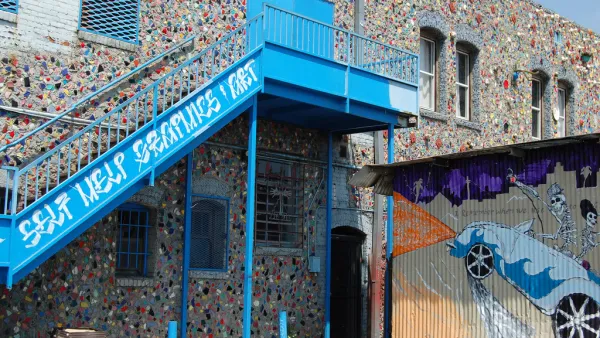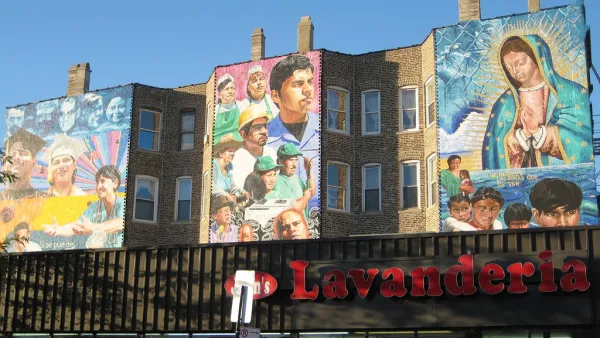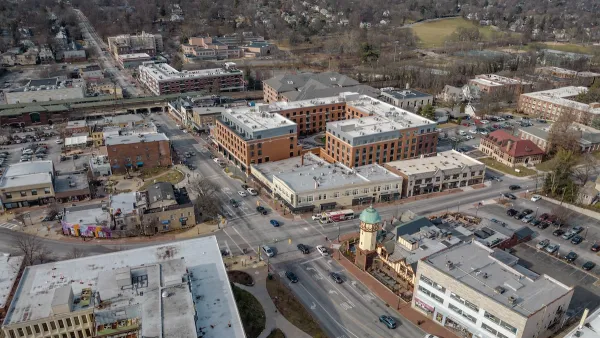Fifty years after the Chicano Moratorium, James Rojas reflects on the future of Latino Urbanism.

James Rojas marks the 50th anniversary of the Chicano Moratorium, a protest against the conscription of young Chicanos to serve in the Vietnam war, with a reflection on the meaning of Latino Urbanism, specifically in East Los Angeles.
Since the protest, which ended in violent disbandment by Los Angeles County sheriffs, Chicano urbanists have reshaped the visual landscape of East Los Angeles. "The charred aftermath of the Chicano Moratorium marked the physical end of Anglo-dominated modernism in East L.A.," writes Rojas.
Departing from the status quo in placemaking, Chicano visionaries, including artists, architects, and citizens, invented and implemented their own unique urban design interventions, says Rojas:
East Los Angeles became the visual manifestation of Aztlan, the mythical region where the Aztecs are said to have originated from. Aztlan was scrawled on many walls alongside gang graffiti. Murals educated and celebrated the power and struggle of the community and were painted on the blank walls of the private and public buildings. ASCO, a group of Chicano artists based in East L.A., used ephemeral interventions, such as a dinner party in a traffic island, performative murals, and sidewalk parades down Whittier Boulevard to create identity through the use of public space.
Looking at East Los Angeles today, the architectural influence of the Latin American architectural movement is clear. Born in the 1960s as the brainchild of a group of Chicano planners and architects, East Los Angeles' El Marcadito was designed "as a community event space based on the design of a market in Guadalajara, Mexico," and stands as a popular reminder of the success and influence of Latino Urbanism.
Given the vibrant relationship of Chicano residents with the built environment, Rojas ends the piece with a pertinent question: "Will Anglo culture assimilate into Latino culture? Or will Anglo landscape incorporate Latino urbanism?"
FULL STORY: The Chicano Moratorium and the Making of Latino Urbanism

Analysis: Cybertruck Fatality Rate Far Exceeds That of Ford Pinto
The Tesla Cybertruck was recalled seven times last year.

National Parks Layoffs Will Cause Communities to Lose Billions
Thousands of essential park workers were laid off this week, just before the busy spring break season.

Retro-silient?: America’s First “Eco-burb,” The Woodlands Turns 50
A master-planned community north of Houston offers lessons on green infrastructure and resilient design, but falls short of its founder’s lofty affordability and walkability goals.

Test News Post 1
This is a summary

Analysis: Cybertruck Fatality Rate Far Exceeds That of Ford Pinto
The Tesla Cybertruck was recalled seven times last year.

Test News Headline 46
Test for the image on the front page.
Urban Design for Planners 1: Software Tools
This six-course series explores essential urban design concepts using open source software and equips planners with the tools they need to participate fully in the urban design process.
Planning for Universal Design
Learn the tools for implementing Universal Design in planning regulations.
EMC Planning Group, Inc.
Planetizen
Planetizen
Mpact (formerly Rail~Volution)
Great Falls Development Authority, Inc.
HUDs Office of Policy Development and Research
NYU Wagner Graduate School of Public Service




























